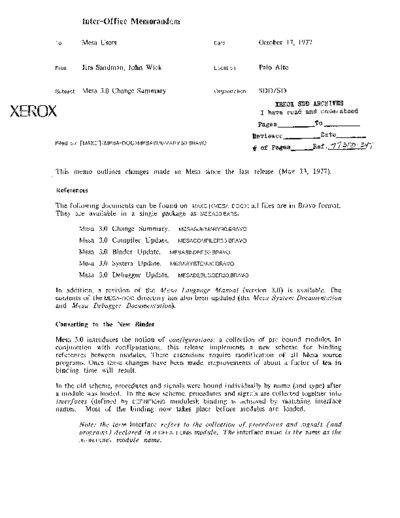Service Manuals, User Guides, Schematic Diagrams or docs for : xerox sdd memos_1977 19771017_Mesa_3.0_Change_Summary
<< Back | HomeMost service manuals and schematics are PDF files, so You will need Adobre Acrobat Reader to view : Acrobat Download Some of the files are DjVu format. Readers and resources available here : DjVu Resources
For the compressed files, most common are zip and rar. Please, extract files with Your favorite compression software ( WinZip, WinRAR ... ) before viewing. If a document has multiple parts, You should download all, before extracting.
Good luck. Repair on Your own risk. Make sure You know what You are doing.
Image preview - the first page of the document

>> Download 19771017_Mesa_3.0_Change_Summary documenatation <<
Text preview - extract from the document
Inter-Office Memorandum
To Mesa Users Date October 17, 1977
From Jim Sandman, John Wick Location Palo Alto
Subject Mesa 3.0 Change Summary Organization SOD/SO
IEF.OX SDD ARCHIVES
XEROX 1 have read and undel'stood
Pages _________ To ---------
Reviewer Da te _ _ __
Filed on: [MAXC]MESASUMMARY30,BRAVO
# of Pages Ref., '115I)D' ::'1/-1
This memo outlines changes made in Mesa since the last release (May l3, 1977).
References
The following documents can be found on [MAXC]; all files are in Bravo format.
They are available in a single package as MESA30.EARS.
Mesa 3.0 Change Summary. MESASUMMARY30,BRAVO
Mesa 3.0 Compiler Update. MESACOMPILER30.BRAVO
Mesa 3.0 Binder Update. MESABINDER30.BRAVO
Mesa 3.0 System Update. MESASYSTEM30.BRAVO
Mesa 3.0 Debugger Update. MESADEBUGGER30.BRAVO
In addition, a revision of the Mesa Language Manual (version 3.0) is available. The
contents of the MESA-DOC directory has also been updated (the Mesa System Documentation
and Mesa Debugger Documentation).
Converting to the New Binder
Mesa 3.0 introduces the notion of configurations: a collection of pre-bound modules. In
conjunction with configurations, this release implements a new scheme for binding
references between modules. These extensions require modification of all Mesa source
programs. Once these changes have been made, improvements of about a factor of ten in
binding time will result..
In the old scheme, procedures and signals were bound individually by name (and type) after
a module was loaded. In the new scheme, procedures and signals are collected together into
interfaces (defined by DEFINITIONS modules); binding is achieved by maLching interface
names. Most of the binding now takes place before modules are loaded.
Note: the term interface refers to the collection of. procedures and Signals (and
programs) declared in a DEFINITIONS module. The interface name is the same as the
DEFINITIONS module name.
Mesa 3.0 Change Summary 2
To use this binding scheme, each PROGRAM module must include (in its module header) a list
of the interfaces it uses (in the IMPORTS clause) and a list of the interfaces it implements (in
the EXPORTS clause). The following steps should be performed:
I) Ensure that all externally referenced procedures and signals are declared in some
DEFINITIONSmodule (Le., in some interface). This is necessary only for items defined
in one module and used in another; e.g. local procedures (which are normally
PRIVATE) need not appear in any DEFINITIONS module.
2) Identify the PROGRAM modules which implement each procedure and signal. These
modules should export the interfaces which declare the items they implement (by
listing the interface names in the EXPORTS clause of the module header).
3) Each module which uses a procedure or signal in a DEFINITIONS module should
import that interface (by listing its name in the IMPORTS clause of the module
header). All EXTERNAL declarations should be eliminated in this step, and replaced by
a reference to some imported interface.
Users should make an initial pass over their programs, performing these steps, before
attempting to compile them with the new compiler. Otherwise a very large number of error
messages (one for each reference to an external item) will be generated.
Example
The following example illustrates the changes which must be made to convert to the new
binder. A fragment of the StreamIO module before conversion is shown below.
DIRECTORY
IODefs: FROM "iodefs",
InlineDefs: FROM "inlinedefs",
StreamDefs: FROM "streamdefs";
DEFINITIONS FROM StreamDefs, IODefs;
StreamlO: PROGRAM [Input, Output: StreamHandle]
IMPLEMENTING IODefs SHARING StreamDefs = PUBLIC BEGIN
-- Externals from Strings
StringToDecimal: EXTERNAL PROCEDURE [STRING] RETURNS [INTEGER];
... ,
ReadDecimal: PROCEDURE RETURNS [INTEGER] =
BEGIN
... ,
RETURN [StringToDecimal[s]]
END;
.. ,
END.
As an aid to conversion, a program has been written which makes a guess as to which
included DEFINITIONS modules should be imported and exported. It also lists all external and
public items which cannot be found in any included interface; these items mllst be assigned
to some interface (or eliminated) as part of the conversion process. Th' nrogram can be
Mesa 3.0 Change Summary 3
found on rMAXC]New Filename: wmanager -- 1324048
>Start Global frame: 1324048
>
When it is started, WManControl should create the common data record and pass a pointer
to it to each of the other modules (as a module parameter), just as the old version of
WManLoader did. To accomplish this, the control module must obtain handles on all the
other modules, in order to START them. The old loader conveniently had a POINTER TO FRAME
for each module which it obtained by instantiating them individually. In the new scheme, all
the modules were instantiated at once, and only the frame of the control module was
returned as a result.
To obtain handles on the other modules in the configuration, we can make use of a new
language feature which allows declarations of PROGRAMS as well as procedures and signals to
be included in DEFINITIONS modules. Such PROGRAMS are part of the interface, and are bound
just as procedures and signals in the interface are. Since we already have an interface
(WManagerDefs) that is shared among all components of this configuration, we just add a
few lines to it.
Mesa 3.0 Change Summary 6
WManagerDefs: DEFINITIONS = BEGIN
◦ Jabse Service Manual Search 2024 ◦ Jabse Pravopis ◦ onTap.bg ◦ Other service manual resources online : Fixya ◦ eServiceinfo